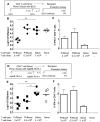Immunological memory transferred with CD4 T cells specific for tuberculosis antigens Ag85B-TB10.4: persisting antigen enhances protection
- PMID: 20011592
- PMCID: PMC2788218
- DOI: 10.1371/journal.pone.0008272
Immunological memory transferred with CD4 T cells specific for tuberculosis antigens Ag85B-TB10.4: persisting antigen enhances protection
Abstract
Background: High levels of death and morbidity worldwide caused by tuberculosis has stimulated efforts to develop a new vaccine to replace BCG. A number of Mycobacterium tuberculosis (Mtb)-specific antigens have been synthesised as recombinant subunit vaccines for clinical evaluation. Recently a fusion protein of TB antigen Ag85B combined with a second immunodominant TB antigen TB10.4 was emulsified with a novel non-phospholipid-based liposomal adjuvant to produce a new subunit vaccine, investigated here. Currently, there is no consensus as to whether or not long-term T cell memory depends on a source of persisting antigen. To explore this and questions regarding lifespan, phenotype and cytokine patterns of CD4 memory T cells, we developed an animal model in which vaccine-induced CD4 memory T cells could transfer immunity to irradiated recipients.
Methodology/principal findings: The transfer of protective immunity using Ag85B-TB10.4-specific, CD45RB(low) CD62L(low) CD4 T cells was assessed in sub-lethally irradiated recipients following challenge with live BCG, used here as a surrogate for virulent Mtb. Donor T cells also carried an allotype marker allowing us to monitor numbers of antigen-specific, cytokine-producing CD4 T cells in recipients. The results showed that both Ag85B-TB10.4 and BCG vaccination induced immunity that could be transferred with a single injection of 3x10(6) CD4 T cells. Ten times fewer numbers of CD4 T cells (0.3x10(6)) from donors immunised with Ag85B-TB10.4 vaccine alone, transferred equivalent protection. CD4 T cells from donors primed by BCG and boosted with the vaccine similarly transferred protective immunity. When BCG challenge was delayed for 1 or 2 months after transfer (a test of memory T cell survival) recipients remained protected. Importantly, recipients that contained persisting antigen, either live BCG or inert vaccine, showed significantly higher levels of protection (p<0.01). Overall the numbers of IFN-gamma-producing CD4 T cells were poorly correlated with levels of protection.
Conclusions/significance: The Ag85B-TB10.4 vaccine, with or without BCG-priming, generated TB-specific CD4 T cells that transferred protective immunity in mice challenged with BCG. The level of protection was enhanced in recipients containing a residual source of specific antigen that could be either viable or inert.
Conflict of interest statement
Figures





Similar articles
-
The HyVac4 subunit vaccine efficiently boosts BCG-primed anti-mycobacterial protective immunity.PLoS One. 2012;7(6):e39909. doi: 10.1371/journal.pone.0039909. Epub 2012 Jun 29. PLoS One. 2012. PMID: 22768165 Free PMC article.
-
Listeria-Vectored Multiantigenic Tuberculosis Vaccine Enhances Protective Immunity against Aerosol Challenge with Virulent Mycobacterium tuberculosis in BCG-Immunized C57BL/6 and BALB/c Mice.mBio. 2022 Jun 28;13(3):e0068722. doi: 10.1128/mbio.00687-22. Epub 2022 Jun 1. mBio. 2022. PMID: 35642945 Free PMC article.
-
T Cells Primed by Live Mycobacteria Versus a Tuberculosis Subunit Vaccine Exhibit Distinct Functional Properties.EBioMedicine. 2018 Jan;27:27-39. doi: 10.1016/j.ebiom.2017.12.004. Epub 2017 Dec 7. EBioMedicine. 2018. PMID: 29249639 Free PMC article.
-
Is interferon-gamma the right marker for bacille Calmette-Guérin-induced immune protection? The missing link in our understanding of tuberculosis immunology.Clin Exp Immunol. 2012 Sep;169(3):213-9. doi: 10.1111/j.1365-2249.2012.04614.x. Clin Exp Immunol. 2012. PMID: 22861360 Free PMC article. Review.
-
[Novel vaccines against M. tuberculosis].Kekkaku. 2006 Dec;81(12):745-51. Kekkaku. 2006. PMID: 17240920 Review. Japanese.
Cited by
-
Early Decision: Effector and Effector Memory T Cell Differentiation in Chronic Infection.Curr Immunol Rev. 2013 Aug;9(3):190-206. doi: 10.2174/1573395509666131126231209. Curr Immunol Rev. 2013. PMID: 24790593 Free PMC article.
-
CBA/J mice generate protective immunity to soluble Ag85 but fail to respond efficiently to Ag85 during natural Mycobacterium tuberculosis infection.Eur J Immunol. 2012 Apr;42(4):870-9. doi: 10.1002/eji.201142054. Eur J Immunol. 2012. PMID: 22531914 Free PMC article.
-
Assessing the effects of multiple infections and long latency in the dynamics of tuberculosis.Theor Biol Med Model. 2010 Nov 8;7:41. doi: 10.1186/1742-4682-7-41. Theor Biol Med Model. 2010. PMID: 21059256 Free PMC article.
-
Vaccine-induced th17 cells are maintained long-term postvaccination as a distinct and phenotypically stable memory subset.Infect Immun. 2012 Oct;80(10):3533-44. doi: 10.1128/IAI.00550-12. Epub 2012 Jul 30. Infect Immun. 2012. PMID: 22851756 Free PMC article.
-
Development of genetically engineered CD4+ and CD8+ T cells expressing TCRs specific for a M. tuberculosis 38-kDa antigen.J Mol Med (Berl). 2011 Sep;89(9):903-13. doi: 10.1007/s00109-011-0760-4. Epub 2011 May 10. J Mol Med (Berl). 2011. PMID: 21556811
References
-
- Andersen P, Doherty TM. The success and failure of BCG - implications for a novel tuberculosis vaccine. Nat Rev Microbiol. 2005;3:656–662. - PubMed
-
- Colditz GA, Berkey CS, Mosteller F, Brewer TF, Wilson ME, et al. The efficacy of bacillus Calmette-Guerin vaccination of newborns and infants in the prevention of tuberculosis: meta-analyses of the published literature. Pediatrics. 1995;96:29–35. - PubMed
-
- Aronson NE, Santosham M, Comstock GW, Howard RS, Moulton LH, et al. Long-term efficacy of BCG vaccine in American Indians and Alaska Natives: A 60-year follow-up study. Jama. 2004;291:2086–2091. - PubMed
-
- Andersen P. Tuberculosis vaccines - an update. Nat Rev Microbiol. 2007;5:484–487. - PubMed
-
- Kamath AT, Fruth U, Brennan MJ, Dobbelaer R, Hubrechts P, et al. New live mycobacterial vaccines: the Geneva consensus on essential steps towards clinical development. Vaccine. 2005;23:3753–3761. - PubMed
Publication types
MeSH terms
Substances
LinkOut - more resources
Full Text Sources
Other Literature Sources
Medical
Research Materials

